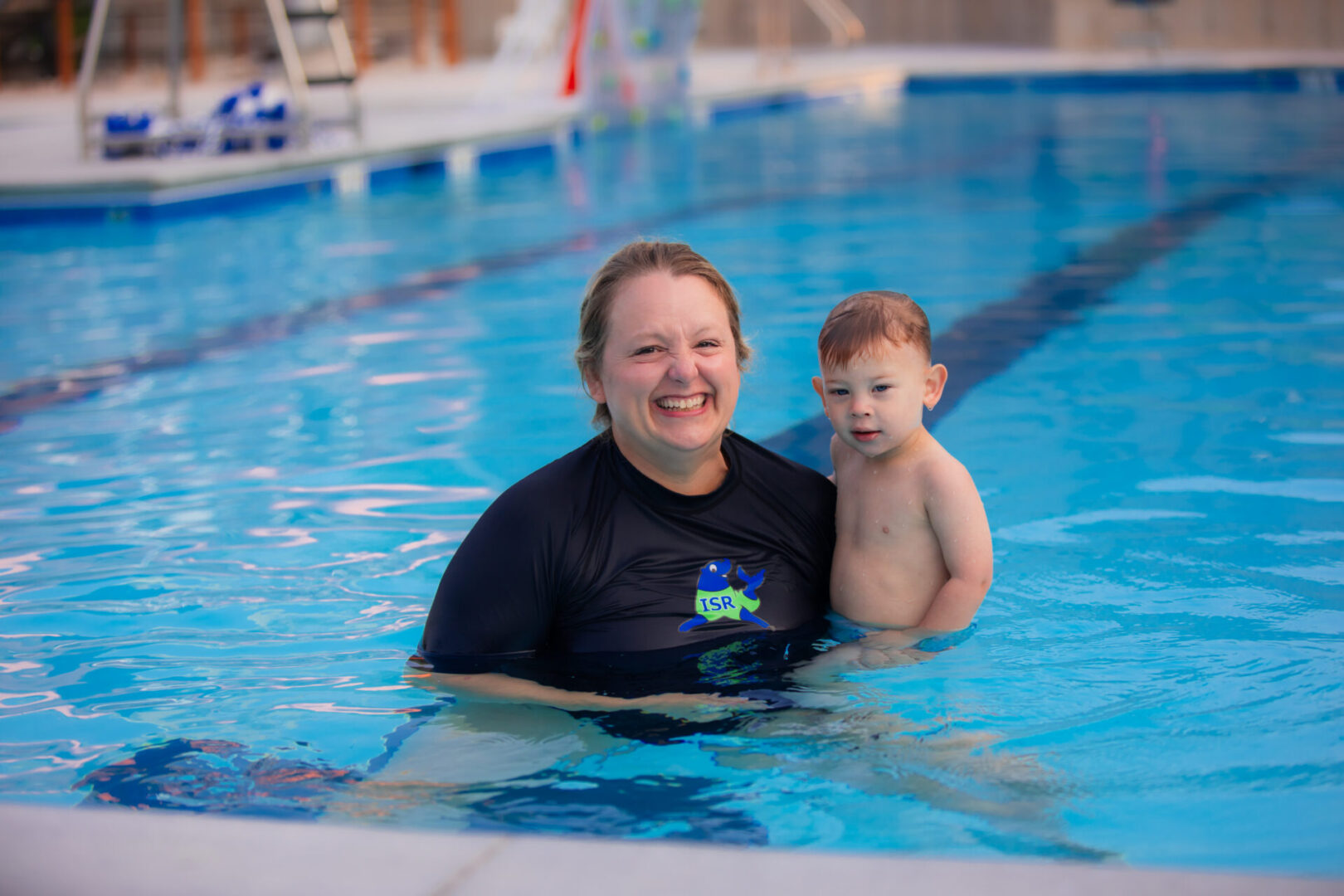
Aquatic Problem Solving Journey Begins Here
ISR is built on consistency, 5 days a week for an average, 6 to 8 weeks, taught by the same skilled ISR-certified instructor. This consistent approach builds trust and confidence quickly.
ISR Foundation Rollback to Float
For infants at this stage, the safest approach in case of independent water entry is mastering the Roll Back to Float method. This involves rolling onto their back, and maintaining a stable float until assistance arrives—a technique both safe and easily sustained. Child must be 6 months of age and able to get to a sitting position by themselves and hold for 1 minute.
Your child will develop:
- Breath Control: Mastery of holding their breath underwater is paramount. Lessons progress only once effective breath control is achieved, ensuring safety.
- Self-Righting Technique: Learning to autonomously transition onto their back from various water entries—head-first, face-first, back-first, or feet-first—
- Unassisted Floating: The ability to float independently, resting and breathing until help arrives, with the flexibility to adjust the float as needed.
- Attire Adaptability: Proficiency in ISR Self-Rescue Skills, initially in a swimsuit, fully clothed with a diaper, and eventually in outerwear like a snowsuit. This ensures adaptability in different aquatic scenarios.
12 Months, Walking And Beyond
ISR introduces the Swim-Float-Swim method. With this training, your child gains the ability to swim independently and navigate toward the safety of the poolside, pond shores, or any body of water. Tailoring lessons to your child's learning style, I aim to build both competence and confidence around water, instilling a profound respect for water safety.
Your child will develop:
- Breath Control: Lessons advance only when your child effectively holds their breath.
- Submerged Head Technique: Learning to swim with their head submerged in the water.
- Float and Breathe: Mastering the ability to roll onto their back to float, rest, and breathe, followed by returning to a swimming position. This Swim-Float-Swim sequence is repeated until they reach the poolside.
- Attire Adaptation: Proficiency in ISR Self-Rescue skills, initially in a swimsuit, fully clothed, and eventually in outerwear like a snowsuit, ensuring readiness for diverse aquatic conditions.
Scheduling and Payment Info
Embarking on your child's ISR journey involves three crucial steps:
- Book on the Scheduler: Begin by selecting suitable time slots on the Scheduler that align with your and your child's availability. This sets the foundation for 5 days a week, 10-minute lessons.
- Checklist Email: A checklist email shall be delivered once you have completed the booking process.
- ISR Registration: How to register with ISR is contained within the Checklist email. All ISR students must be approved by ISR. For new students, the cost is $105, and for returning students is $40.
- Payment $125 per week x 6 weeks = ($750) with full payments due on first day of lessons. This payment is nontransferable and nonrefundable.
- ISR Foundation and Walking and Beyond full payment is due on the first day of lessons ($750).
- Maintenance Lessons, $25 per swimmer per day.
- Refresher Lessons, $125 per swimmer per week.
- Pricing is subject to change.
Essential for Successful Lessons
- Schedule Lessons: Choose your target start date and book lessons through the Scheduler.
- Complete ISR Registration: Look for the ISR Registration link in the email you receive after deposit payment. Lessons can only commence once ISR approves the registration.
- Read The Parent Resource Handbook: Familiarize yourself and your child with important information for successful lessons.
- Order Cloth Swim Diapers
- Note Payment Due Date: Check the checklist email on how to pay at each facility. Some are weekly and some are 6 weeks upfront all are non-refundable.
- Family Calendar: Add lesson dates to your family calendar for easy reference. Make sure you are not scheduling lessons during family vacations.
- Prepare a Swim Bag: Pack a swim bag with 3 towels, 2 cloth swim diapers (or one disposable and one cloth), extra dry clothes, and any necessary items for the poolside.
- Arrive 15 Minutes Early: Schedule and arrive 15 minutes before class to ensure you and your child are ready for a successful lesson.

Scholarships and Gift Certificates
Explore available scholarships from various agencies and non-profits. Both you and the instructor must meet specific requirements. Scholarships provide an excellent opportunity for your child to receive lessons. Reach out if you're interested in applying for a scholarship. Gift Certificates available upon request.

